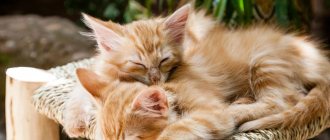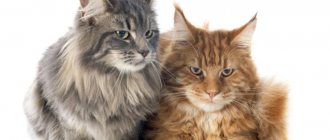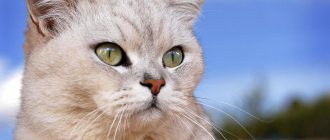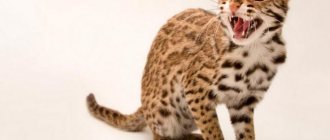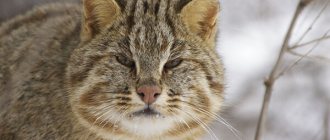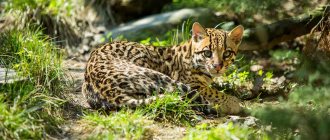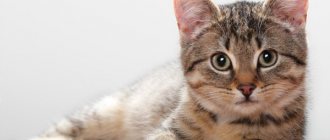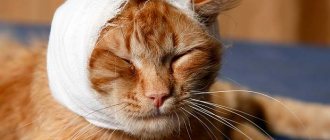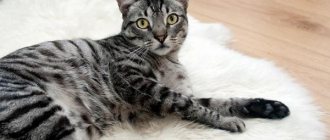7087Administration
Domestic cats are not only pets of familiar breeds. A manul cat at home is very exotic. There are people who are ready to make their furry friend a unique animal that is on the verge of extinction and, in order not to disappear from the face of the Earth, needs serious help from humans.
We are talking about a steppe cat, which is called manul or pallas. Its Latin name is felis manul, and its synonym is otocolobus (translated as “ugly ear,” although its rounded ears are not at all ugly). The description of the appearance of a powerful pallas with very thick and long fur, the size of a large domestic cat, is very attractive, but the best idea of this impressive animal is given by a photo. The wild cat Pallas is not often kept at home, but it can still become a four-legged pet. However, when deciding to get such a pet, it is necessary to take into account many of its features, since the Pallas's cat, even raised in captivity, cannot fully adapt to being kept at home and always remains a wild animal at heart.
© shutterstock
Characteristics and description of the appearance of the Pallas's cat
Manul is a predatory representative of the cat family . The second name, Pallas's cat, was given in honor of P. S. Pallas, a German naturalist who was the first to describe the cat in 1776.
The Latin name Otocolobus translates as "dwarf ear" . The word "manul" is of Turkic origin.
The cat is attractive with its lush fur, fatness and stern look . The appearance of the cat is deceptive; many people think that it is a large animal, but in fact the body length of males does not exceed 62 cm, on average - 50-55 cm. Tail length - 23-31 cm, weight - 2.5-4 kg. Females are slightly lighter than males, body length is approximately the same - 49-53 cm, maximum 60 cm.
The cat's head is round and medium in size . The ears are set wide. A distinct pattern is visible on the muzzle, the front part is flat.
The color of the iris is yellow . A characteristic feature of Pallas' cats is that their pupils do not narrow in bright light, but remain round.
The cheeks are covered with tufts of long hair.
The limbs are short , the tail is thick, covered with gray hair, the tip is black.
The coat is thick and fluffy . On one square cm of the back grows about 9 thousand hairs 7 cm long. The color of the coat is light gray and fawn-ochre, hairs with white tips. It seems as if the cat's fur coat is dusted with snow. On the tail and back of the body there are narrow transverse stripes of dark gray color; vertical black stripes are visible from the corners of the eyes on the sides of the muzzle. The fur on the belly is brown with a white coating.
Scientists agree that Pallas cats are close relatives of Persian cats . This conclusion is based on the appearance of the animal. Persians have a similar coat structure, head shape, and rounded shape, which distinguishes them from other breeds.
Wild cats vary in color and size depending on the subspecies and habitat :
- Otocolobus manul manul are typically colored animals that live throughout most of their range, often found in western China and Mongolia.
- Otocolobus manul ferruginea - animals with a red-ocher color, with clear red stripes, living in Iran, Turkmenistan, Uzbekistan, Kyrgyzstan, Afghanistan, Kazakhstan, Tajikistan, Pakistan.
- Otocolobus manul nigripecta are greyish-colored animals that turn silvery-gray in winter, living in Kashmir, Tibet and Nepal.
On average, cats live 11-12 years . Individuals who end up in zoos have a high chance of living a long life. For example, in the Moscow Zoo one cat lived to be 18 years old.
Reference. The Pallas's cat was the symbol of the capital's zoo in 1987-2014.
The first wild cats appeared in the country's main zoo in the 50s. XX century , and since 1975, zoo workers began breeding them regularly.
Some zoos in Europe and the USA purchased kittens. Despite the difficulties of breeding and keeping in captivity, the Moscow Zoo has become the leader in the number of Pallas' cat births.
Lifestyle, natural habitats
The species is included in the third category of protection, as rare on the periphery of its range, and is included in the Red Books of Russia, China, Kyrgyzstan, Kazakhstan, and Mongolia. This is one of the least studied representatives of felines, whose habitat occupies an area from Transcaucasia to eastern Mongolia. Pallas' cats live in Armenia, Azerbaijan, China, Russia, India, Iran, Kazakhstan, Kyrgyzstan, Mongolia, Pakistan, Turkmenistan, and Uzbekistan.
Scientists do not name the exact number of manuls, since it is impossible to carry out calculations . Cats lead a solitary lifestyle, prefer to hide away from human eyes, and they do not have the best relationships with their fellow cats. At the same time, there is scientific evidence that although their habitat has not changed over the past few decades, the population size is declining every year. It is known that Pallas' cats have disappeared from the Caspian region and Eastern China.
At the turn of the 1990-2000s. the total number of Pallas' cats in Russia was estimated at 3000-3650 individuals.
Reference. The species is endangered and is included in the Potential Threat subcategory of the Reduced Risk category of the IUCN Red List, as well as in Appendix II of the CITES Convention.
Over the past 15 years, cats living in open steppes have been almost completely exterminated , and their habitat is becoming limited. Pallas' cats prefer to settle in treeless mountainous areas, arid regions, rocky deserts and steppes of Asia and southern Siberia.
The northern border of the range is located on the territory of Russia, which borders Kazakhstan, Mongolia and China. Cats live in Altai, Tuva, Buryatia and the Chita region in steppe and semi-desert areas with herbaceous and shrub vegetation located fragmentarily, in areas with finely dissected relief, rocky areas, low mountains with outcrops.
The most comfortable living conditions are rocky outcrops and large areas of bushes . Here cats make their abode and hide during the day. The climate in the area is sharply continental, the air temperature in winter is -50 °C. Pallas' cats do not settle where the snow depth exceeds 20 cm, since their short legs are poorly adapted to move through such terrain.
Pallas' cats lead a sedentary lifestyle . The peak of activity occurs mainly at dusk and early morning. During the day, cats sleep in a den, which they make in rock crevices, under stones, caves, and in abandoned burrows of foxes, marmots, and badgers.
Reference. The color of the Pallas's coat is determined by its habitat and helps it hide among stones and thickets when hunting.
By themselves, these wild cats are slow and clumsy . They are not adapted to fast running and often become prey to large dogs, predators and humans. Cats often turn towards their pursuer, stop, sit on the ground or lie on their backs.
The characteristic behavior in case of danger is hiding, which can be fatal for the animal. To escape from enemies, cats climb onto rocks and stones. Alarmed animals begin to purr hoarsely or snort sharply.
Interesting things on the site:
How the Sphynx cat breed was developed
Description of the Havana Brown cat breed
Burmilla breed
Key Features
A lonely warrior of the steppes - this is how the Pallas's cat is characterized.
The cat, whose photo has spread all over the Internet, has a complex character; it is not easy for her to get along with her relatives.
At their core, cats with a serious expression on their faces are loners.
They make their home in rock crevices, in small caves, and do not disdain old fox and badger holes.
They go hunting with the stars, as befits predators. However, Pallas's cat hunting at dusk or dawn is also not uncommon.
Interesting! Pallas cats are not averse to walking during the day, especially in spring and summer. They, like other cats, love to soak up the sun.
Pallas cats do everything in their lives slowly. They sedately and leisurely track down prey and attack from ambush.
Manul at home
In the wild, Pallas' cats lead a solitary lifestyle . They have no contact with humans or other animals. Even when meeting relatives, cats show pronounced aggression. For this reason, domestication of these wild cats is impossible.
The character of the Pallas's cat is very unpredictable . He can sit quietly in a secluded corner and glare at you, or at one moment turn the apartment upside down. Torn furniture, wallpaper, doors, flooring, curtains, tulle, broken dishes, fragments of your favorite porcelain vase on the floor - you should prepare for all this when your Pallas' cat is at home.
The long and thick fur of the Pallas's cat sheds all year round , and during the heating season it also flies in clumps. You will have to comb your pet every day, which is problematic due to the notorious vicious disposition. The teeth and claws of the Pallas's cat will be used against you at any opportunity, even if you are not guilty of anything, but only tried to pet your pet.
Wild cats a priori cannot feel comfortable in an apartment . They are hot, stuffy, with nowhere to hide. In its habitat (Transbaikalia), winters are frosty and snowy, and the air temperature is best suited for animals. There are no dangerous viruses or bacteria here, so cats live a long time in their natural environment. In an alien environment, they face danger in the form of toxoplasmosis, which “mows down” both adults and young animals. Even in zoos, where Pallas' cats are cherished as the apple of their eye, the mortality rate among kittens is extremely high.
Daredevils who try to keep Pallas' cat in apartments quickly become horrified and try to get rid of their pets; at best, they hand them over to zoos. There are several factors that make it impossible to keep Pallas cats at home :
- intolerance to high indoor temperatures;
- refusal to eat, if the food causes mistrust, or if the appearance or smell does not suit the cats;
- a sharp decrease in immunity and susceptibility to diseases;
- stubborn, self-sufficient character;
- impossibility of training and taming;
- aggression towards humans and animals.
Feeding
In the wild, Pallas' cats feed on hamsters, voles, gerbils, pikas, ground squirrels , partridges and chukars. Sometimes they catch tolai hares, young marmots, and small birds. When hunting, cats sneak along the ground, guarding their prey near stones and holes. Cats remove rodents from shallow burrows with their paws. The animal's diet also includes insects.
In zoos, Pallas' cats are fed meat, green cereals, and bone meal is mixed into the food . The favorite dish of predators is the carcasses of rodents and quails. Feeding time is evening.
At home, cats are fed their usual food . The basis of the diet is rodent meat, poultry, greens, and cereals. Vitamin supplements containing calcium are essential for maintaining musculoskeletal health.
Is it possible to keep him at home?
Unlike its relatives, the Pallas's cat cannot be domesticated due to its indomitable nature. It is believed that if any animal is taken home when it is still a small kitten, it can grow up tame, with behavior no different from a domestic cat. But this is not about the manula. There are no guarantees that it will take root. Even if he is raised by a domestic cat along with his kittens, the manul will not be able to love them, and when he grows up, he will be aloof both from his half-sisters and brothers, and from people whom he has known since childhood. You need to know about this in advance before the manul appears within the walls of the house in order to make a decision for yourself whether such a wayward pet will suit you.
Health and common diseases
An adult carpet cat has excellent health and rarely gets sick if it lives in its habitat. Changes in the usual way of life and climate negatively affect the physical and emotional state of animals. Even when kept as Pallas' cat cats in the zoo, they rarely live to a ripe old age.
Despite successful breeding in zoos, most of the cubs die from toxoplasmosis. Adults are also susceptible to this dangerous disease. Treatment of animals is very problematic; sick cats do not allow people to approach them, behave extremely aggressively, try to grab a hand or throat, which is fraught with very serious consequences, because their teeth are sharp and their jaws are strong.
Nutrition
The composition of Pallas' cat food in the wild depends on its habitat and season.
The diet of this rare and peculiar predator in nature consists of:
- mouse-like Daurian pikas (about 50%);
- various insects (up to 20%);
- partridges, swifts, pigeons, bluetails, quails (about 10%);
- small mammals such as ground squirrels, jerboas, hamsters, voles;
- berries and plants.
In zoos, representatives of this species are pampered with meat and rodents such as lemmings .
Pallas' cats, who are not very sociable, become gentle and attentive during the mating season. The male wins a mate in battles
Reproduction
The breeding season for Pallas' cats in the wild is February-March . Females bear kittens for 74-75 days, the offspring are born in April-May. The litter size is 2-10 kittens, with an average of 3-5. Pallas' cat cubs are born blind and helpless, weighing 300-400 g, 10-12 cm long. The female is responsible for raising them entirely. At 2 months, kittens shed their hair and weigh 500-600 g. At the age of 6-8 months they reach the size of an adult animal.
As for breeding Pallas' cats at home, this is possible, but rarely practiced . Those who have tried to breed wild cats note that Pallas cat kittens are not much different from kittens of domestic breeds - they are just as affectionate and funny. But during puberty, cute kittens turn into demons and begin to terrorize family members.
Manul is not a domestic cat . Let us give as an example the story of one Pallas's cat, who now lives in a zoo, and before that “delighted” one Moscow family with his evil rumbling. The cute cat has grown up and taken a dominant position in the house. The family was afraid to move around the apartment, because the cat was waiting for them at every corner and rushed to bite.
In fact, this is typical behavior for Pallas cats. Up to a certain age, they are like angels in the flesh, but soon they change their behavior to the exact opposite, so much so that it’s time to call an exorcist. Still, nature takes its toll. Pallas' cats are clearly not intended for pets.
Price
The wild popularity of the Pallas's cat made him not only the hero of memes and the king of the Runet, but also prompted many connoisseurs of the species to look for places of sale. On thematic forums, some sellers quote prices of tens of thousands of US dollars . And this despite the fact that cats are listed in the Red Book, and their trade is punishable by law.
Anyone who dreams of buying a Pallas's cat should know that cats cannot be tamed ; they are not in the mood for human contact. At best, they simply tolerate the presence of others. Animals respond to an invasion of personal space in two ways - either they ignore the intruder, or they use claws and fangs, the length of which is three times longer than that of an ordinary cat.
Appearance
The dimensions of a Pallas cat are not much different from the dimensions of a regular cat.
Outwardly, it looks quite massive: a sort of ball of fur on short thick legs.
In fact, his weight is the same as that of a cat. For reference, this animal is almost half the size of a completely domestic Maine Coon .
The impressive fur of the Pallas's cat adds impressiveness.
Interesting! Other small cats cannot boast of such a unique and thick coat as the wild manul. Nine thousand hairs are located on one square centimeter of his back.
The Pallas's cat makes his home in rock crevices, in small caves, and does not disdain old fox and badger holes.
But this is not its only difference.
Species characteristics of the animal:
- strong physique;
- flattened muzzle;
- gray wool with lightened tips;
- black stripes on the body and tail, black tail;
- whitened tips of fur on the top of the ears;
- two black stripes on the cheeks;
- bulging yellowish eyes with round pupils (in domestic cats they are vertical).
Pallas cats do everything in their lives slowly. They sedately and leisurely track down prey and attack from ambush. They prefer to wait for prey near the hole. Wild seals have a good reaction, which allows them to hunt successfully
Interesting Facts
Some interesting facts about Pallas's cat:
- In 1996, the Tajikistan Post dedicated a series of 12 stamps to Pallas's cat. Postage stamps with cats were also issued in Azerbaijan, Mongolia, and Kyrgyzstan.
- The Pallas cat was included in the issues of UN and Benin stamps, which were dedicated to rare species of animals.
- In 1996, Turkmenistan issued a commemorative silver coin with a face value of 500 manat, on which the Pallas cat was displayed.
- In October 2012, the Pallas's cat was chosen as the mascot of the Moscow Zoo by electronic voting.
- In 2008, the “Pallas cat” meme appeared on the RuNet in the form of images of a cat with the caption “Pet the cat.”
- In 2021, the Bank of Russia issued a silver coin with a face value of 2 rubles, dedicated to the Pallas cat from the “Red Book” series.
- Pallas' cats are found in mountainous areas at an altitude of 3000-4800 m.
- Dense fur and short legs make it difficult for a cat to move, so a fast-running Pallas' cat is a rare occurrence.
- When in danger, wild cats hide in the hope that no one will notice them. But if he is found, the attacker will not be happy. Manul fights desperately, not for life, but for death.
- Pallas' cats tolerate cold temperatures down to -50°C . They are protected by thick fur.
- Pallas' cats are loners by nature ; they do not need the company of their relatives. The fathers of the offspring shift the responsibility for raising the kittens to the female, but in case of danger they will kill any offender.
- Each animal lives on an area of up to 10 km².
- Pallas' cats cannot meow , but they snort and growl great.
- Pallas cats prefer to remain silent . Even kittens are silent so as not to attract the attention of enemies.
- Pallas' cat is an ancient creature . Scientists estimate its age at 12 million years. Thanks to their secluded lifestyle, their appearance has changed little.
Character
Manul is a wild animal that not everyone can tame. The animal is active at night. During the day, the predator tracks prey, waiting for it near holes or stones. The cat is slow, his strong trait is perseverance. The manul can track its prey for a long time, waiting for the right moment.
It seems that Manul is an unbridled predator and it is difficult to instill the habits of a domestic cat. And yet its character differs from firmly established associations. Yes, this is a careful animal that will not risk its health in vain.
Yes, he is slow, so he would prefer to wait a few more hours rather than rush headlong into his prey. This is a born master of camouflage, which can wait for hours for prey in the bushes or other secluded place. The animal feels good early in the morning. He devotes the rest of his time to sleep and rest.

